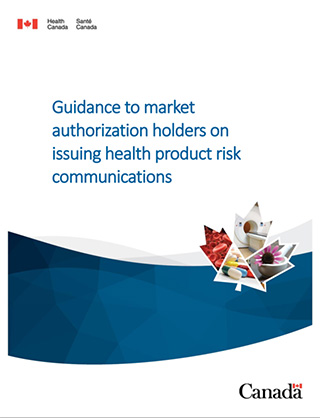Guidance to market authorization holders on issuing health product risk communications: Overview
On this page
Purpose
The purpose of this document is to assist market authorization holders (MAHs) develop and disseminate health product risk communications (HPRCs).
Scope
The guidance provided in this document is limited to HPRCs. An HPRC is a specific type of risk communication generated using the Health Canada-developed HPRC template and standardized process. HPRCs are designed to clearly and effectively communicate information to health care professionals about new health-related risks associated with marketed health products such as:
- drugs
- medical devices
- natural health products.
The guidelines and procedures described in this document assume that a decision to issue an HPRC has already been made. This document doesn't describe the criteria used to determine whether an HPRC is the ideal risk communication tool to address a particular risk.
Background
Mitigating the risks associated with health products often involves disseminating the most current information on new or emerging risk issues (that is, issues pertaining to health product safety, efficacy or quality). This information helps health care professionals and the public make informed treatment decisions.
Different risk communication strategies may be needed to address varied risk issues. Determining when, how and what should be communicated is based on a number of factors. These may include:
- the seriousness of the issue
- the type of persons affected
- the reliability of the information
- the size of the population impacted
An HPRC is a type of risk communication designed by Health Canada to assist MAHs communicate clinically significant health product risk information to the broader health care professional community. HPRCs are designed to promote a consistent approach to communicating the most accurate, relevant and complete information about a risk issue. This approach is supported by a standardized HPRC template, as well as a collaborative process involving both Health Canada and MAHs, to develop and disseminate HPRCs.
Health Canada must approve HPRCs before they are issued. As such, MAHs are advised to follow the guidelines and procedures described in this document to ensure timely approval of their HPRCs.
HPRCs shouldn't be used to communicate on issues that don't pose a risk to health (that is, promotional, administrative or other purposes). Alternative communication vehicles should be considered for issues that fall outside the scope of an HPRC.
Note about guidance documents in general
Guidance documents provide assistance to industry and health care professionals on how to comply with governing statutes and regulations. They also provide guidance to Health Canada staff on how mandates and objectives should be met fairly, consistently and effectively.
Guidance documents are administrative, not legal, instruments. This means that flexibility can be applied. However, to be acceptable, alternate approaches to the principles and practices described in this document must be supported by adequate justification. They should be discussed in advance with the relevant program area to avoid the possible finding that applicable statutory or regulatory requirements have not been met.
As always, Health Canada reserves the right to request information or material, or define conditions not specifically described in this document, to help us adequately assess the safety, efficacy or quality of a therapeutic product. We are committed to ensuring that such requests are justifiable and that decisions are clearly documented.
This document should be read along with the relevant sections of other applicable guidance documents.
Page details
- Date modified:
